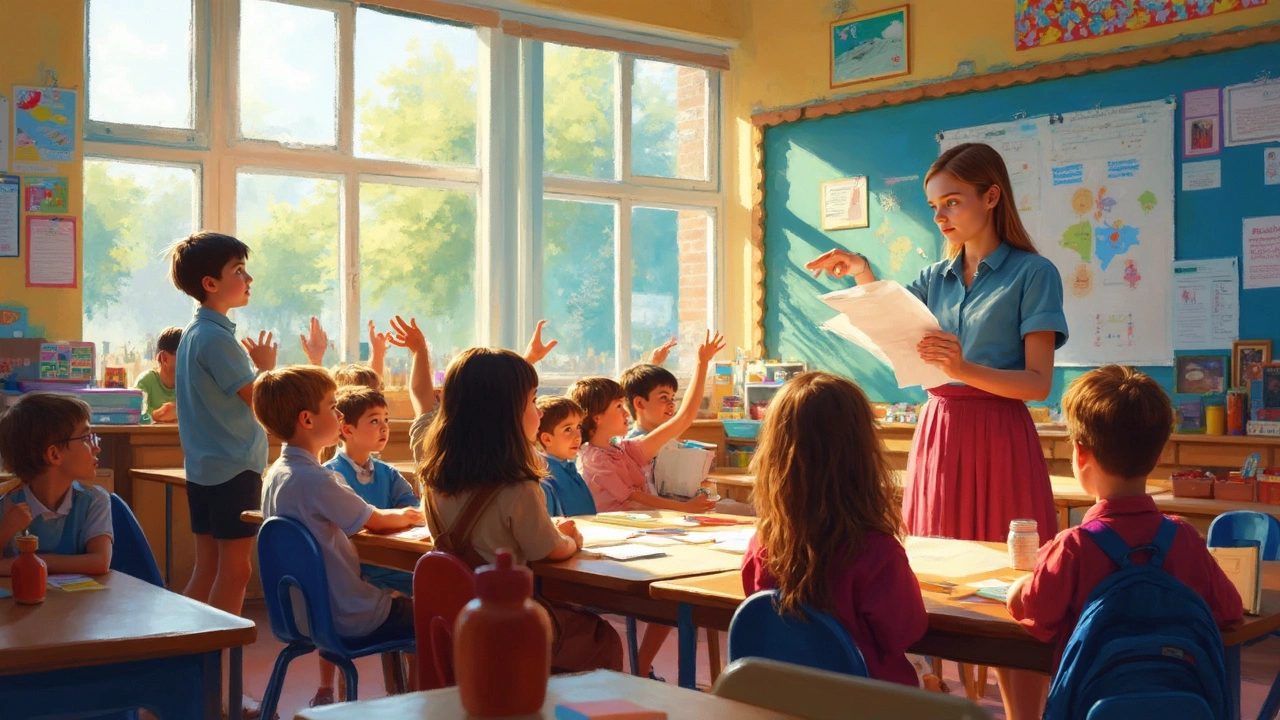Ever wondered what it's really like to step into a classroom and take charge as a new teacher? That's where student teacher training comes into play. It's a crucial stage where theory meets practice in the teaching world. You don't just learn about teaching methods—you actually get to use them, right there with real students.
Think about it: textbooks can teach you about lesson planning and engagement, but they can't prepare you for the curveballs students might throw your way. Here, you're not just a passive observer but an active participant, figuring out what works and what needs tweaking in your approach.
This hands-on experience is more than just ticking off a requirement. It's building a toolkit filled with strategies for managing a classroom and connecting with students. Imagine facing challenges and solving them with guidance from seasoned teachers. It's a learning curve, no doubt, but one that sharpens and shapes you into a confident educator.
- Understanding Student Teacher Training
- Benefits of Hands-On Experience
- Challenges Faced During the Training
- Tips for Maximizing the Training Experience
- Preparing for a Successful Teaching Career
Understanding Student Teacher Training
So, you're diving into the world of student teacher training. It’s like a rite of passage for aspiring teachers, where classroom dreams meet reality. But what exactly does it involve?
What’s the Goal?
The main aim is to blend theoretical knowledge with hands-on experience. You’re stepping into the shoes of a teacher, with real students in front of you. It’s about putting all those teaching methods and strategies you've learned into practice.
The Training Structure
Typically, student teacher training is part of your education degree program. You’ll have a supervising teacher guiding you, helping you adjust your sails as you navigate through lesson planning, classroom management, and maybe even some unexpected hiccups.
Steps in the Process
- Observe and Learn: Initially, you might spend time observing your mentor teacher’s classes. This helps you get a feel for how they run their classrooms.
- Co-Teaching: Next, you might start co-teaching. Here, you’ll begin sharing responsibilities and trying out your teaching techniques under supervision.
- Independent Teaching: Finally, it’s your turn to take the lead, planning and executing your lessons independently. Your supervisor will still offer feedback and support.
It's Not All Rosy
Challenges? Oh, absolutely. Each day brings new lessons. From handling the tech that’s supposed to help but often hinders, to keeping a diverse group of students engaged—it's a learning curve you can't skip. But it’s all part of the process of becoming a competent, effective teacher.
This training sets you on a path to making a difference in students' lives. And isn’t that what teaching is all about?
Benefits of Hands-On Experience
Getting involved directly in the classroom can make all the difference for aspiring teachers. This student teacher training provides an invaluable, realistic glimpse into the life of a teacher. It's not just about understanding the curriculum; it's about effectively delivering it, which is where hands-on experience truly shines.
Real-World Classroom Dynamics
During this phase, you face real-world classroom dynamics and learn to adapt on the fly. Understanding how to keep a class engaged isn’t a one-size-fits-all. Some days, it's about channeling a bit of drama for a literature class; on others, it's using tech tools for interactive sessions. Each day presents its own unique scenario, keeping you on your toes.
Building Confidence and Skills
There's something about standing in front of a classroom that helps build confidence. By consistently engaging with students, you refine your communication skills and develop an assertive teaching style. A 2023 study from the University of Education showed that those with hands-on experience felt 40% more confident in their teaching abilities than their peers who didn't have the same exposure.
Mentorship and Feedback
Arguably one of the most helpful aspects of this teacher training is the mentorship you receive. Seasoned teachers offer guidance—they’ve been through the ups and downs. Their feedback can provide new perspectives, helping tweak your strategies to better suit different learning environments.
Creating a Professional Network
Meeting fellow student teachers and experienced staff can lay the groundwork for a solid professional network. Sharing insights, discussing strategies, and exchanging ideas broadens your understanding and offers fresh approaches to challenges you're bound to encounter.
Student teacher training ensures you're not just theoretically equipped but practically prepared to manage and nurture a dynamic classroom environment. It’s an experience that fosters growth, adaptability, and readiness for the rewarding journey of teaching.

Challenges Faced During the Training
Embarking on student teacher training is exciting, but let's be real, it comes with its fair share of challenges. It’s not just about standing in front of a classroom—it’s about adapting, learning, and sometimes stumbling. So, what are some of these hurdles?
Classroom Management
One of the first hurdles is classroom management. You might have planned for the perfect lesson, but did you think about keeping thirty energetic students engaged? Balancing time, keeping control, and ensuring each student is focused can feel like juggling multiple balls while standing on a unicycle.
Balancing Theory with Practice
Another common struggle is integrating theory with practice. Textbooks often paint a rosy picture of how lessons should ideally flow. In reality, things can go off script pretty quickly. How do you respond when you’ve lost the class’s attention or when your activity doesn't spark the interest you hoped for?
Feedback Overwhelm
Then there's the feedback—a crucial component but sometimes overwhelming. You're constantly being observed by mentors, who are there to help, but it can feel like you’re under a microscope. It’s important to remember that constructive criticism is your friend, not your foe.
Time Management
Let’s not forget time management. Balancing lesson planning, assignments, and sometimes even part-time jobs can be taxing. You might need to nap less and plan more, which can be a tough adjustment.
Diverse Student Needs
Lastly, catering to diverse student needs is no small feat. Every classroom has students with different learning styles and needs, and figuring out how to cater to them all while hitting your lesson goals is a real challenge but immensely rewarding when you get it right.
Tackling these challenges head-on will not only make you a better teacher but also prepare you for the unpredictable nature of teaching. Each hiccup is a stepping stone to becoming a well-rounded educator.
Tips for Maximizing the Training Experience
Diving into student teacher training is an exciting yet challenging phase. Here are some solid tips to make the most of it:
1. Set Clear Goals
Start by setting clear and realistic goals. Think about what skills you want to develop, be it classroom management or designing engaging lesson plans. Writing these goals down can help keep you focused and motivated throughout your training.
2. Communicate with Your Mentor
Your mentor is a valuable resource. Regularly discuss your progress and seek their feedback. Not only does this help build a strong professional relationship, but it also gives you insights into improving your teaching techniques.
3. Reflect on Your Lessons
After each lesson, take time to reflect on what worked and what didn’t. Keeping a journal can be useful for noting down observations and reflecting on students’ reactions. It's an excellent way to track your growth and adapt your methods.
4. Embrace Classroom Challenges
Don’t shy away from challenges. Whether it's dealing with disruptive students or unexpected changes, these experiences are learning opportunities. They prepare you for similar situations in your future teaching career.
5. Get Involved in School Activities
Join extracurricular activities or school events to understand the school culture better. It's a great way to connect with students outside the classroom setting and hone your interpersonal skills.
- Volunteering at events
- Helping with school clubs
- Attending staff meetings
6. Collaborate with Peers
Working with other student teachers offers fresh perspectives and ideas. Share experiences and teaching strategies. Collaboration often leads to innovative ways to engage students.
7. Stay Open to Feedback
Receiving feedback is vital for professional growth. Embrace it as a tool for improvement rather than a critique. Constructive feedback often highlights areas that might not be obvious to you.
8. Keep Up with New Teaching Trends
Education is always evolving. Read up on new teaching strategies and technologies. Implementing contemporary methods can make your teaching sessions more dynamic and relevant.
Remember, the key to a successful education career begins with a proactive and open-minded approach during your training. Every day in the classroom is a step towards becoming a skilled and effective educator.

Preparing for a Successful Teaching Career
So, you're on the path to a teaching career and ready to dive into a world that’s as inspiring as it is challenging. Let's talk about how to gear up for success. This isn't just about ticking boxes—it's about laying a solid foundation for your future as an educator.
1. Build a Strong Support Network
Having a network of fellow student teachers, mentors, and experienced educators is crucial. They’ll provide guidance when things get tough and celebrate your wins, no matter how small. Don’t hesitate to join online communities or local teacher groups to share insights and get advice.
2. Keep Learning as a Lifelong Habit
Teaching isn’t static; it's ever-evolving with new research and technologies. Make a habit of continuous learning by attending workshops, seminars, and further training sessions. An updated skill set keeps you relevant and effective.
3. Practical Tips for Classroom Management
Effective classroom management is key to a smooth teaching experience. Start by setting clear rules and expectations from the get-go. Use positive reinforcement to encourage good behavior and maintain a supportive atmosphere. Here’s a quick checklist:
- Establish rules collaboratively with students.
- Implement consistent routines.
- Address issues calmly and promptly.
4. Mastering Lesson Planning
A well-prepared lesson plan can make or break your teaching day. Tailor your plans to cater to diverse learning styles and ensure they’re engaging. Here’s how you can improve:
- Incorporate a variety of teaching aids like visuals and interactive activities.
- Be flexible—if a plan doesn't work, be ready to tweak it.
- Always have a backup plan for unforeseen circumstances like tech failures.
5. Importance of Reflection
Regular reflection on what went well and what didn’t is vital. Keep a teaching journal to jot down insights after each day. This helps in recognizing patterns and improving your approach.
6. Relevant Statistics on Teaching Careers
Let's look at some enlightening numbers. According to a 2023 study by the European Education Policy Network, teachers who actively engaged in professional development were 25% more effective in classrooms. Here's a quick overview:
| Activity | Effectiveness Increase |
|---|---|
| Professional Development | 25% |
| Mentorship Programs | 20% |
Having these strategies and insights under your belt sets you on the right track for a fulfilling and successful teaching journey. Teaching is as much about growth as it is about imparting knowledge, and with these practices, you're well-prepared to nurture both in your career.
